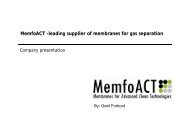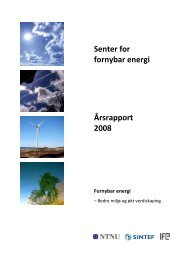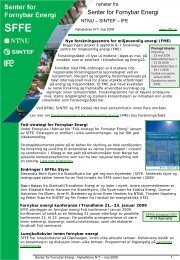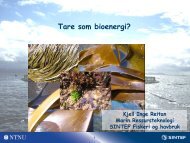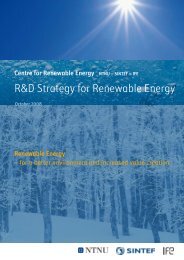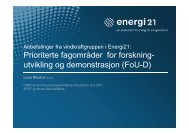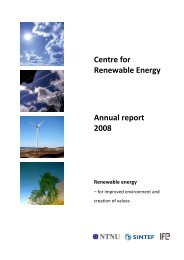Sustainable Road Transport - SFFE
Sustainable Road Transport - SFFE
Sustainable Road Transport - SFFE
Create successful ePaper yourself
Turn your PDF publications into a flip-book with our unique Google optimized e-Paper software.
<strong>Sustainable</strong> <strong>Road</strong> <strong>Transport</strong><br />
Ann Mari Svensson<br />
SINTEF Materials and Chemistry<br />
Lunch meeting, 27.02.2008,<br />
The Centre for Renewable Energy<br />
”Renewable energy for improved<br />
environment and creation of values”<br />
www.sffe.no
Emissions from transportation<br />
The transportation sector<br />
contributes by 37 %<br />
to the domestic<br />
emission of GHGs<br />
Aviation Railw ay<br />
8 % 0 %<br />
Ships<br />
28 %<br />
Personal<br />
(car+bus)<br />
46 %<br />
Sources: Facts 2007, SSB<br />
Trucks<br />
18 %
Increase in road transportation (source: SSB)<br />
~1.5%<br />
~3.2 %<br />
Estimated increase 1 :<br />
Private vehicles: 0.7% (-> 2012) 0.8% (2012-2020)<br />
Heavy vehicles: 1.7% (-> 2012) 0.9% (2012-2020)<br />
1<br />
St. meld. No 24, Nasjonal <strong>Transport</strong>plan 2006-2015
The transportation sector<br />
Emissions from <strong>Transport</strong>ation down by 78 %,<br />
14,4 million tons CO 2 equ. within 2050<br />
Low emission path:<br />
50-80 % reduction by 2050,<br />
Stabilize CO 2<br />
at around 450 ppmv<br />
(ca 550 ppmv CO 2<br />
equiv.),<br />
Temp increase ~3-4 o C<br />
Source: Commission of Low Emissions, 2006
Options for reduction of GHG emissions<br />
• More environmentally friendly fuels and energy<br />
carriers, like<br />
– electricity, biofuels and hydrogen<br />
• More efficient vehicles<br />
– Power trains with improved fuel/energy utilization<br />
(including also hybrid vehicles and all-electric cars)<br />
– Reduced weight of vehicles<br />
• Reduction of the transportation<br />
– Reduction of transportation work in terms of person km,<br />
and ton km of transported goods<br />
– Increased number of passengers per vehicle, public<br />
transport, car-pooling etc.
Alternative technologies and fuels for emission<br />
reduction<br />
• Improved efficiency<br />
(Existing and new technology)<br />
– Combustion Hybrid<br />
– Batteries drive<br />
– Fuel cells<br />
• Hybrid vehicles<br />
– ~ 40% improvement of fuel econonomy,<br />
city driving<br />
- US: 1% market share 2005<br />
– Toyota 61%, Honda 30%, Ford 5%, GM 4%<br />
– Benefits, California (Air Resource Board):<br />
• Federal Tax Deduction (US$ 2000)<br />
• ”Clean Air Vehicle Stickers”<br />
> 45 miles/gallon (CNG, H 2 og el-biler)<br />
• Alternative fuels<br />
– Ethanol<br />
– Biodiesel<br />
– Hydrogen<br />
– NG/LNG<br />
– LPG<br />
– DME<br />
Hytan<br />
Hytan-fyllestasjon<br />
fyllestasjon, Malmø
<strong>Transport</strong>ation<br />
Efficiency, „tank-to-wheel“, EDC<br />
90 %<br />
80 %<br />
Elektrisk motor<br />
70 %<br />
1liter petrol=100%<br />
Effektivitet<br />
Private<br />
car Driving<br />
1997<br />
(CCFA)<br />
91% Idling<br />
9%<br />
Total amount of<br />
Mechanical<br />
energy to heat<br />
energy<br />
72%<br />
19%<br />
Kinetic<br />
energy<br />
Friction<br />
16%<br />
Heat loss<br />
1%<br />
cooling system<br />
Loss,<br />
auxiliarie<br />
47% Heat loss,<br />
2%<br />
exhaust<br />
Loss,<br />
25%<br />
Resistance<br />
breakin<br />
11%<br />
5%<br />
60 %<br />
50 %<br />
40 %<br />
30 %<br />
20 %<br />
10 %<br />
0 %<br />
Hybrid<br />
Bensinmotor<br />
Turtall<br />
Brenselcelle<br />
Dieselmotor
Plug-in hybrids<br />
Toyota plug-in hybrid,<br />
Available 2010,<br />
7 mile battery range<br />
Source: Electric power research institute, 2006
Plug-in hybrids, typical fuel consumption: 40% of<br />
conventional vehicles<br />
Source: Electric power research institute, 2003
Hydrogen in the transportation sector: Vehicles<br />
• Conventional internal combustion engines (ICEs)<br />
– Otto engines (e.g., BMW, Ford)<br />
– Wankel engine (Mazda)<br />
• Hybrid vehicles (with ICEs converted to hydrogen)<br />
– Hybridization with ICE as only power source (e.g., Toyota Prius)<br />
– Plug-in hybrids (prototypes coming, e.g., Toyota, GM)<br />
• Fuel cell vehicles<br />
– Range extenders (e.g., Th!nk Hydrogen)<br />
For lease: 20 000<br />
NOK/month!!<br />
HYNOR<br />
– Weak or no hybridisation (e.g., Opel Zafira HydroGen 3)<br />
– Strong hybrids (e.g., Toyota FCV and Honda FCX)<br />
Toyota Prius Hydrogen Mazda RX8 BMW 7-series
Hydrogen supply and storage<br />
• Renewable: Water electrolysis (commercially available, Norsk<br />
Hydro++) alkaline electrolyzers, PEM electrolyzers<br />
• Onboard storage, compressed hydrogen, 350 – 700 bar<br />
• Challenges:<br />
– Vehicles, infrastructure, costs, ”hen and egg”
Fuel cell activities, NTNU and SINTEF<br />
Activities:<br />
• Performance characterisation and evaluation<br />
• Assessment of membrane/electrode degradation<br />
• Effect of fuel impurities (CO, Cl 2 )<br />
• Modelling (electrodes, single cells)<br />
• Thermal effects<br />
• Alternative fuels (reformed hydrogen,<br />
methanol)
Hydrogen production, activities at NTNU<br />
• PEM-water electrolysis<br />
– From catalyst development to product<br />
1997<br />
2001<br />
H 2 -production rate<br />
Nm 3 H 2 /hour per m 2 electrode area<br />
Cell voltage /Volt<br />
0 5 10 15<br />
2.0<br />
1.8<br />
1.6<br />
1.4<br />
PEM electrolyser<br />
1.2<br />
Alkaline electrolyser<br />
1.0<br />
0 10 20 30 40<br />
4.4<br />
3.9<br />
3.4<br />
2.9<br />
2.4<br />
Specific energy consumption<br />
kWh/Nm 3 H2<br />
2006<br />
Current density / kA/m 2
Biofuels<br />
• Could potentially contribute to significant GHG emission reductions<br />
• 1st generation: bioethanol, biodiesel – from plants<br />
• 2nd generation: bioethanol, biodiesel, flexible raw material,<br />
incl. wood/waste wood/waste -> Norway<br />
• Challenges: Competition with other applications<br />
Domestic utilization of biomass:<br />
• Domestic biomass resources: ca 14 TWh/year used for buildings/industry<br />
(annual growth ~30 TWh/year)<br />
• Ambitions for increased utilization:<br />
Source: Tijmensen et al,<br />
– 14 TWh/year (Klimameldingen)<br />
– 20 TWh/year (NVE)<br />
8 TWh/year<br />
– 25 TWh/year (optimists)<br />
• Challenges: Not yet commercial<br />
Large scale production (2nd gen)
2nd generation biodiesel<br />
• Synthetic biodiesel: ca 40% conversion efficiency from wood<br />
Source: Concawe
Bioethanol<br />
Conversion efficiency from wood ~ 30 – 35 %
Bio-alcohol Production from<br />
Ligno-cellulosic Biomass<br />
Lignocellulosic<br />
biomass<br />
Pre-treatment Hydrolysis Fermentation<br />
Distillation or<br />
separation<br />
Wood, grain straw,<br />
bagasse<br />
Whole process<br />
analysis<br />
Physical separation of<br />
the lignocellulosic fibers<br />
Enzymatic or chemical<br />
hydrolysis of cellulose<br />
and hemicellulose to<br />
release C6 and C5<br />
mono-sugars<br />
Fermentation of C6<br />
and C5 mono-sugars<br />
to alcohols by<br />
microorganisms<br />
Separation and<br />
concentration of<br />
alcohol<br />
Nordic collaboration project<br />
Internal SINTEF project<br />
Evaluation of the<br />
biorefinery<br />
concept
Summary, alternative fuels and technology<br />
Biofuel, Hybrid, All-electric, Hydrogen<br />
Biofuel, Hybrid
Emissions from road transport<br />
Propulsion<br />
technology<br />
Vehicle<br />
Average age of<br />
private cars (2006):<br />
19.7 years<br />
Distribution [%]<br />
Ca 52% of person km on short trips (< 20 km)<br />
25 %<br />
20 %<br />
15 %<br />
10 %<br />
5 %<br />
0 %<br />
< 1 km 1-1.9<br />
km<br />
Source: TØI<br />
Fuel<br />
2-2.9<br />
km<br />
3-4.9<br />
km<br />
5-9.9<br />
km<br />
Travel distance [km]<br />
Drive pattern<br />
10-<br />
19.9<br />
km<br />
> 20<br />
km<br />
Average number of persons in car<br />
Average number of persons per car<br />
decreases over time<br />
2<br />
1.8<br />
1.6<br />
1.4<br />
1.2<br />
1<br />
0-2 km 2-5 km 5-10 km 10-20<br />
km<br />
20-50<br />
km<br />
Length of trip [km]<br />
50-100<br />
km<br />
> 100<br />
km
Scenarios for emission reduction<br />
Scenario A: ”conventional” technologies<br />
• Large scale, domestic production of biofuel, 20 TWh biomass,<br />
reserved for heavy duty vehicles:<br />
– 2012: FT plant, synthetic diesel, 8TWh biomass<br />
– 2016: Small scale ethanol production, 4 TWh biomass<br />
– 2022: FT plant for synthetic diesel, 8TWh<br />
• Growth in transport demand is assumed according to public forecasts.<br />
• Maximum number of electric vehicles:<br />
31 % of the car park, corresponding to 1 car for every household with<br />
2 or more cars.
Scenario A<br />
Commission of Low Emissions<br />
- is it at all possible?<br />
Share of new cars<br />
1.2<br />
1<br />
0.8<br />
0.6<br />
0.4<br />
0.2<br />
Electric cars<br />
Hybrid cars<br />
Conv. cars<br />
0<br />
2000 2010 2020 2030 2040 2050<br />
Year
Scenario A<br />
Commission of Low Emissions<br />
- is it at all possible?<br />
100 %<br />
Car pool<br />
80 %<br />
60 %<br />
40 %<br />
Electric cars<br />
Hybrid vehicles<br />
(fossil)<br />
Conv. cars<br />
20 %<br />
0 %<br />
2005<br />
2010<br />
2015<br />
2020<br />
2025<br />
2030<br />
2035<br />
2040<br />
2045<br />
2050<br />
Year
Scenario A<br />
14<br />
Commission of Low Emissions<br />
- is it at all possible?<br />
Mt CO2 equiv pa<br />
12<br />
10<br />
8<br />
6<br />
4<br />
Reference path<br />
Bio+hybrid+electric<br />
Low emission path<br />
Bio + Plug-in<br />
hybrid<br />
2<br />
0<br />
2000 2010 2020 2030<br />
Year<br />
2040 2050 2060
Summary, results (scenario A)<br />
• 62 % coverage of fuel for heavy duty vehicles from domestic biofuel<br />
(20 TWh)<br />
• Corresponding emission reduction (biofuel) is 2.2 Mton CO 2 equiv per<br />
year<br />
• 20 TWh biomass for residential heating<br />
⇒ replace 15 TWh of electricity,<br />
⇒ reduction of 12 Mton CO 2 equiv per year, electric vehicles<br />
(Scandinavia)<br />
• Electric vehicles (31% of all cars), 24 % of the total vehicle km<br />
travelled, consumption of 2.2 TWh, emission reduction amounts to<br />
2.2 Mton CO 2 equiv per year.
Scenario B: Extensive introduction of hydrogen<br />
• In addition to the assumptions introduced for Scenario A,<br />
the following is assumed:<br />
– Extensive introduction of hydrogen vehicles from 2020.<br />
In 2030-2035, all new cars purchased will be either<br />
hydrogen vehicles, or electric vehicles.<br />
=> Zero emission road transportation in 2050.
Scenario B<br />
Commission of Low Emissions<br />
- is it at all possible?<br />
Share of new cars<br />
1.2<br />
1<br />
0.8<br />
0.6<br />
0.4<br />
Hydrogen cars<br />
Electric cars<br />
Hybrid cars<br />
Conventional cars<br />
0.2<br />
0<br />
2000 2010 2020 2030 2040 2050 2060<br />
Year
Scenario B<br />
100 %<br />
Commission of Low Emissions<br />
- is it at all possible?<br />
Car pool<br />
80 %<br />
60 %<br />
40 %<br />
Hydrogen<br />
Electric<br />
Hybrid<br />
Conventional<br />
20 %<br />
0 %<br />
2005 2010 2015 2020 2025 2030 2035 2040 2045 2050<br />
Year
Commission of Low Emissions<br />
- is it at all possible?<br />
Scenario B<br />
14<br />
12<br />
Mt CO2 equiv pa<br />
10<br />
8<br />
6<br />
4<br />
2<br />
Reference path<br />
Bio+hybrid+el+H2 (ely)<br />
Bio+hybrid+el+H2(NG,CCS)<br />
Low emission path<br />
”Other mobile sources”<br />
Lack of biofuel for heavy vehicles<br />
0<br />
2000 2010 2020 2030 2040 2050 2060<br />
Year
Further implications, Scenario B<br />
• Introduction of hydrogen<br />
⇒ reduction of 4.5-5 Mton CO 2 equiv<br />
• Power for hydrogen to FC vehicles (2050)<br />
⇒ 12 TWh annually.<br />
• NG to hydrogen (incl. CCS) for H2 ICE hybrid vehicles (2050)<br />
⇒17 TWh NG (LHV).<br />
• By gasification of 20 TWh biomass to hydrogen<br />
⇒ reduction of 6.2 Mton CO 2 equiv per year in FC car<br />
⇒ 3.8 Mton CO 2 equiv per year in a ICE H2 hybrid vehicle
Konklusjon<br />
‣Stor utfordring å erstatte fossile<br />
drivstoff – ressurser må utnyttes<br />
optimalt!<br />
‣Reduksjon av utslipp fra veitrafikk er<br />
mulig, men tar lang tid.<br />
Begynn nå!
<strong>SFFE</strong><br />
Contact Information<br />
Director Johan Hustad, NTNU<br />
E-mail: johan.e.hustad@ntnu.no<br />
Co-ordinator Åse Lekang Sørensen<br />
E-mail: ase.lekang.sorensen@ntnu.no<br />
www.sffe.no
Teknologistatus<br />
Brenselcellebiler (status 2007)<br />
Specifications<br />
Number of passengers 4<br />
Motor<br />
Max.<br />
Output<br />
Max.<br />
Torque<br />
Type<br />
95kW (129PS, 127 horsepower)<br />
256N•m (26.1kg•m, 188.8 lb-ft.)<br />
AC synchronous motor (Honda mfg.)<br />
• Honda Toyota<br />
– Imponerende ytelse (se tabell t.h.)<br />
– Rekkevidde 570 km!<br />
• Effektivitet på 60%!<br />
• Kostnad ikke oppgitt<br />
Fuel cell<br />
stack<br />
Fuel<br />
Type<br />
Output<br />
Type<br />
Storage<br />
Tank<br />
Capacity<br />
Dimensions (L×W×H)<br />
Max. Speed<br />
Energy Storage<br />
Vehicle Range*<br />
PEFC<br />
(proton exchange membrane fuel cell,<br />
Honda Mfg.)<br />
100kW<br />
Compressed hydrogen<br />
High-pressure hydrogen tank (350atm<br />
171 liters<br />
4,760 × 1,865 × 1,445mm<br />
(187.4 × 73.4 × 56.9 inches)<br />
160km/h (100 mph)<br />
Lithium Ion Battery<br />
570km (354 miles)<br />
* When driven in LA4 mode (Honda calculations)
Alternative fuels in transportation<br />
100 %<br />
90 %<br />
80 %<br />
Share of fuel<br />
70 %<br />
60 %<br />
50 %<br />
40 %<br />
30 %<br />
20 %<br />
10 %<br />
0 %<br />
All no.2 cars (urban)<br />
Primarily for trucks(ships)<br />
2005<br />
2010<br />
2015<br />
2020<br />
2025<br />
2030<br />
2035<br />
2040<br />
2045<br />
2050<br />
2055<br />
2060<br />
2065<br />
Gasoline<br />
Diesel<br />
Hydrogen (Fuel Cells)<br />
Hydrogen (ICE)<br />
Electrical vehicles<br />
Bio fuels<br />
2070<br />
2075<br />
2080<br />
2085<br />
2090<br />
2095<br />
2100<br />
2105



